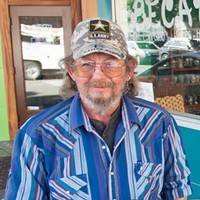The first deluge of winter has come and gone, but it will be at least another month before extreme weather shelters open across Humboldt County. The shelters generally open when there is more than an inch of rain or temperatures fall below the low 30s, and are usually volunteer-led efforts that help people without homes to escape from the elements. With a significant portion of Humboldt County's indigent population living outdoors, they can be lifesavers. But organizers often struggle to get — and keep — the doors open.
The number of people living unsheltered in the county is the subject of some debate. While the official Point in Time Count, conducted biannually by volunteers and organized by the county Department of Health and Human Services, shows a sharp decrease in this population — from 936 in 2015 to 350 in 2017 — many homeless advocates feel these numbers do not reflect the true number of people living rough in the streets, woods and beaches of the county. (See "No Homeless People in Southern Humboldt?", May 19, 2017).
In January of 2017, volunteers in the Eel River Valley counted 23 people sleeping without shelter, down from 96 in 2015.
Rhonda Lewis, director of Fortuna Adventist Community Services (FACS), says she is certain the number is inaccurate.
"I think it was just a different count," she says. "For some reason ... we didn't go out and beat the bushes or lure them in. We counted the ones that came in for coffee and doughnuts."
FACS operates an emergency weather shelter out of its ground floor on Rohnerville Road, where it also has an emergency family shelter with showers and supplies. When the temperatures dip or heavy rain is predicted, volunteers go outside with bright pink signs advertising shelter. But despite a record year of heavy rains, the shelter did not open for many nights last winter due to a dearth of volunteers. For safety reasons, the shelter requires two volunteers willing to spend the entire night, as well as a church member onsite. (Lewis says she often sleeps in her office on nights the shelter is open.) Volunteers must be over 21, willing to do a two-hour training and equipped to handle what Lewis calls "some pretty rough characters."
Ann Burroughs, a Ferndale resident, is part of a new group, Eel River Advocacy for Shelter, which formed in response to this issue. Burroughs and her husband volunteered at the shelter last year — but just once.
"I won't spend the night again, I'm too old," she tells the Journal. Instead she is reaching out to local college students and agencies, offering volunteers a chance to gather community service hours. The new group, which may become a 501(c)(3), will offer training in November and is currently accepting crates so people can bring their dogs in from the cold, as well.
In Southern Humboldt, where no unsheltered people were counted in 2017 despite a total of 124 in 2015, volunteers are scrambling to find a new venue since the shutdown of the John Haynes Memorial Veteran's Hall (See "Closed," Oct. 20, 2016) and a fire that burned down the Community Presbyterian Church. The church also housed the region's food bank (it has since rebounded and moved). Peg Anderson, owner of Chautauqua Foods, has worked with the Southern Humboldt Emergency Shelter Group to raise enough money to pay potential venues $100 a night. She says the shelter was open about 17 nights last winter, accommodating between eight and 20 people. (Dogs are not allowed.) Anderson says there have been no issues during the overnights, but potential volunteers need to be prepared for a variety of personalities.
"Some people are mentally unstable. Other people are using drugs," she says. "A lot of them are not, they're just really tired. Half or more are elderly."
Anderson recently helped organized a series of "listening circles" between Garberville residents and the transient workers that descend on the small town every cannabis harvest season. Residents have complained about people hanging out in large groups in the town square, dogs, smoking, fighting and inappropriate language.
"It was very effective to listen to each other rather than glaring," she says. Many people in the area looking for work are coming up short on both employment and shelter, placing a heavy burden on social services. It remains to be seen what will happen when winter rolls around, but at least one group is looking for more permanent solutions.
"We're in a real pickle," says Debra Carey. "Lots of things are gone to us."
Carey is a co-founder of Alternative Homeless Housing Alternatives, which has worked for several years to establish a tiny house village for homeless people in Humboldt County. At the Nov. 7 Board of Supervisors' meeting, the group will attend public comment to present petitions bearing more than 1,000 signatures in support of declaring a shelter crisis for the entire county, which would loosen up some building restrictions. Carey says the group has been offered land "all over the county" but is sticking to its guns that any site must be near resources and/or a bus line.
"I've worked with people long enough to know what they need," she says. "If we could get a shelter crisis declaration, we could relax liability so we could have a tiny house village or camp."
In the meantime, only homeless folks living rough in Arcata and Eureka might be guaranteed shelter where the Arcata House Partnership and Eureka Rescue Mission reliably offer meals and a warm place to sleep. Bryan Hall, the mission's executive director, says that since the facility's renovation, there has not been a need to send overflow clients to the St. Vincent de Paul cafeteria, although that space will probably be used again if necessary. On its busiest night last year, the Rescue Mission took 160 men, women and children in from the cold. Hall says extra space not-withstanding, the organization is always in need of blankets, food and money for the water bill.
Immediately to the north, Dahl Sims, who organizes Arcata House Partnership's emergency shelter, is also gearing up for the cold weather. The shelter, which operates out of a rotating set of churches in the area, will be open by Dec. 1 "unless something catastrophic happens." The most people Arcata House can accommodate on any given night is 20. When temperatures drop, Sims hits the phone tree for volunteers and puts signs at Ninth and F streets in Arcata, as well as other high traffic areas for homeless folks, directing people to the Arcata House's annex near the transit center, where staff can do an intake.
"We also network that information to get people involved in CalFresh, help with Social Security programs, and MediCal," says Sims. "Clients get showers, a dry change of clothes, a dinner at night. We transport them to whichever church is the host for that particular night. They get a walkaway breakfast. It's pretty comprehensive for them."
The National Oceanic and Atmospheric Administration is predicting an average winter in terms of both temperature and precipitation, but it remains anyone's guess as to how busy Sims and his cohort will be when the season comes at full force. Last year's record rains stretched both Arcata House's budget and volunteer base.
"This would be my fifth year doing this and I haven't seen any winter like that," Sims says.
Editor's note: This story was edited from a previous version, in which Peg Anderson was paraphrased as saying volunteers needed to be "tough." Anderson called after the story went to print to say that her words were misinterpreted. The Journal apologizes for any confusion.Linda Stansberry is a staff writer at the Journal. Reach her at 442-1400, extension 317, or [email protected]. Follow her on Twitter @LCStansberry.





Comments